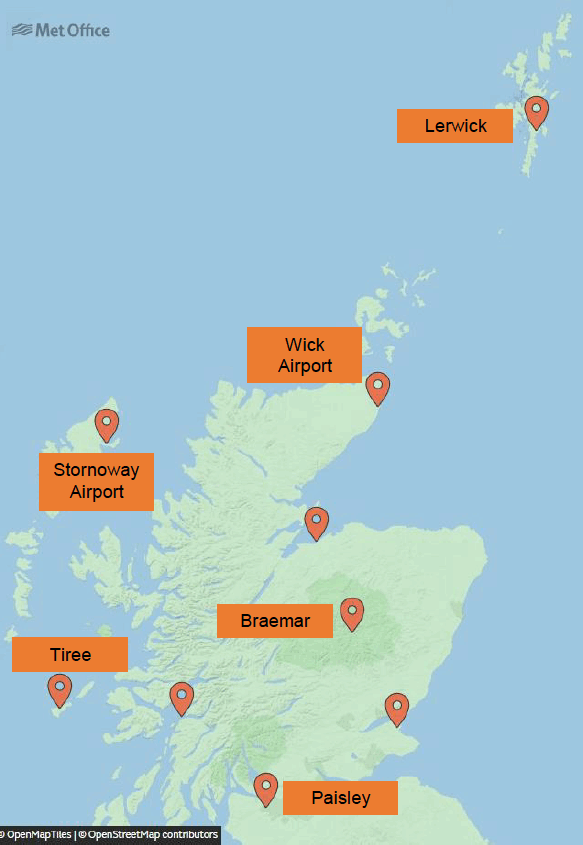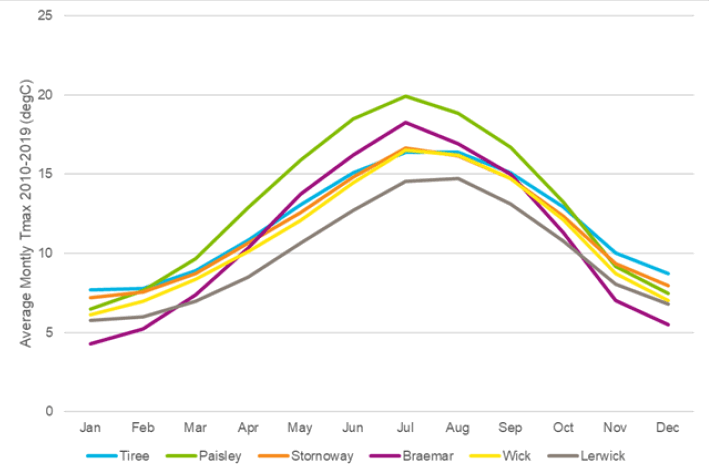Building regulations - overheating risk in new homes: research report
Research into overheating risk in new homes. Produced in support of proposed improvements to energy standards for new buildings within Scottish building regulations in 2021.
This document is part of a collection
4. Weather Data Comparison
4.1 To assess the potential impact of location on the overheating risk of new homes in Scotland a high-level comparison of weather data for different parts of the country has been carried out. This analysis compares peak temperature data for a number of locations (inland, coastal and islands) in Scotland to identify the potential impact location will have on overheating risk.
4.2 The Met Office operate several weather stations in Scotland and publish historic data from the locations listed below:
- Lerwick
- Stornoway Airport
- Wick Airport
- Nairn
- Braemar
- Leuchars
- Paisley
- Dunstaffnage
- Tiree
4.3 For the purposes of this analysis, six locations have been selected to compare a range of climates covering different areas of Scotland including inland, coastal and island locations. Figure 3 shows which locations have been selected for this comparison[3]:

4.4 The data analysed covers a 10-year sample period from 2010 to 2019 (2020 data is currently provisional and therefore has been excluded). Figure 4 and Table 4 show the 10-year average of the peak temperatures recorded for each month at each selected location.

| Month | Tiree | Paisley | Stornoway | Braemar | Wick | Lerwick |
|---|---|---|---|---|---|---|
| Jan | 7.7 | 6.5 | 7.2 | 4.3 | 6.1 | 5.8 |
| Feb | 7.8 | 7.6 | 7.6 | 5.2 | 7.0 | 6.0 |
| Mar | 8.9 | 9.7 | 8.7 | 7.4 | 8.4 | 7.0 |
| Apr | 10.8 | 12.9 | 10.7 | 10.3 | 10.1 | 8.5 |
| May | 13.1 | 15.9 | 12.6 | 13.7 | 12.1 | 10.7 |
| Jun | 15.1 | 18.5 | 14.8 | 16.2 | 14.5 | 12.7 |
| Jul | 16.4 | 19.9 | 16.7 | 18.3 | 16.5 | 14.6 |
| Aug | 16.8 | 18.8 | 16.2 | 16.9 | 16.2 | 14.7 |
| Sep | 15.1 | 16.7 | 14.7 | 15.0 | 14.7 | 13.1 |
| Oct | 12.9 | 13.2 | 12.3 | 11.3 | 12.1 | 10.8 |
| Nov | 10.0 | 9.2 | 9.3 | 7.0 | 8.7 | 8.0 |
| Dec | 8.7 | 7.5 | 8.0 | 5.5 | 7.0 | 6.8 |
4.5 Figure 4 and Table 4 show that the average peak temperatures recorded in Paisley are the warmest of those selected from March to October; for six months of the year this is at least 1.5°C hotter than the next warmest location.
4.6 The most northerly location, Lerwick, has the lowest average peak temperature, which is approximately 2°C lower during the summer months than the next most northerly location, Wick; and is cooler than Paisley by approximately 5°C during the summer.
4.7 The coastal and island locations of Tiree, Stornoway and Wick all have similar average peak temperatures during the summer months, with less than 1°C difference between them. These locations are at least 2°C cooler than Paisley during the summer.
4.8 The overheating analysis presented in Section 3 is based on Glasgow weather data. Given that the average peak temperatures are greatest for Paisley/Glasgow in Table 4, it would reasonable to expect that risk of overheating in new homes is similar or lower in at least most of the rest of Scotland assuming that Paisley/Glasgow continues to have the highest peak temperature in the future. This further suggests that the mitigation measures proposed for Glasgow should be suitable for controlling the risk of overheating for at least most other locations as well.
Contact
Email: buildingstandards@gov.scot
There is a problem
Thanks for your feedback